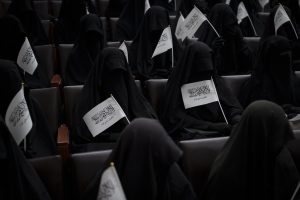Three years ago, Roya was well on her way to her lifelong dream of a career in medicine. She excelled in her high school classes and took extra tutoring sessions to prepare for the Kankor or university entrance exam. When she took the exam in early 2021, she was thrilled to receive one of the highest marks in the country.
Now she says she regrets all that work. “There is no future for me in Afghanistan,” Roya said.
Three years of Taliban rule have made it clear that policies toward higher education are not just about separating men and women, but are about remaking Afghan society. Taliban policies and oppression have worked to gradually, but effectively, undo much of the expansion of higher education between 2001 and 2021 and have changed how a generation of Afghans are thinking about their futures.
While international media attention focused mostly on the banning of girls from secondary education, the Taliban’s strategy toward higher education suggests they view this area as a priority in their work to remake Afghan society. Minister of Higher Education Neda Mohammad is a close ally of Hibatullah, the supreme leader of the Taliban regime, and the head of the Office of the National Examination Authority is a key member of the Haqqani group.
This is an extreme reorientation from the Ministry of Higher Education of the democratically-elected government, which with international support, expanded the number of students in universities to almost half a million between 2001 and 2021.
Born in 2003 in Kabul, Roya embodied a generation of Afghans who came of age under a democratically-elected government. She comes from a family that supported her educational journey and she took advantage of the private tutoring centers that sprang up during those years.
At least initially, the Taliban did not say that they were banning women from universities, and Roya and her family remained somewhat hopeful.
“When I entered university, I thought that this was the first step towards getting to know different people,” she recalled. “Instead, what I found was something completely different.” Taliban guards enforced a strict dress code and treated the students roughly.
One of Roya’s Islamic studies professors asked her why she was there. “‘Women have no need to study,’ he said, ‘they should be at home,’” she recounted the professor telling her.
And then, in December 2022, the Taliban banned women completely from universities. At first Roya hoped this would be temporary, as many officials suggested publicly. As more and more time passed, however, she felt the opportunity to study slip further from her grasp. Even if Taliban officials do allow women to return to the classroom, it is clear that the schools they will be returning to will be completely different.
Taliban officials have made curricular changes slowly, but steadily. They have increased the number of Islamic studies courses required in all faculties and eliminated many of the course they feel are too Western in orientation. Now authorities are reviewing other curricula and there are expected changes, particularly in the social sciences.
The Taliban have reinvested in religious education. In their first two years in power 5,618 new religious schools were opened, up from the 1,212 that existed under the previous government. Many of those interviewed reported concerns that only those with religious educations were likely to get jobs after graduating.
Despite the failings of the democratically-elected Afghan government and its international partners to provide security and reliable economic growth between 2001 and 2021, higher education is one sector where there was significant growth. Now that progress is slowly but intentionally being rolled back.
We have been conducting research on the state of higher education in Afghanistan for the past year, as these changes have been slowly rolled out. We have been collecting educational biographies from Afghans both inside the country and those who have fled in order to better understand the current state of higher education in Afghanistan.
While there are deep differences between those who remained and those who fled, between men and women, and between Afghans from different social classes, the central theme in these interviews has been one of regret and loss. That raises serious questions about the future of the country.
Even more liberally-minded, often urban, families who supported women’s education are now treating girls differently. Instead many families now feel that the safest thing for their daughters is pushing them to marry at a younger age. Amnesty International and other groups have noted similar trends in increasing numbers of child marriages.
Even for male students, there is an increased sense that emigrating is a better strategy than attempting to study in Afghanistan. This past year, only 97,000 students took the Kankor exam, down from over 200,000 in 2020, when the top scorer was a woman from Kabul.
For those who began their quest for higher education under the democratically-elected government, the volte-face has been particularly painful. “Why did I spend so much effort preparing to pass the Kankor exam and be accepted to a field that I was interested in?” Roya lamented. “Why didn’t I study English or computer science, or something that would qualify me to apply for a scholarship and study elsewhere? If I knew English, I would have gone abroad to study.”
“I am really disappointed that I was born in Afghanistan,” she concluded sadly.

































